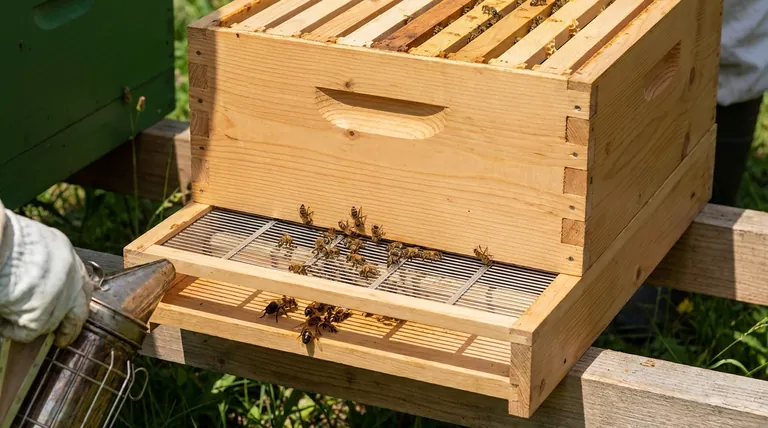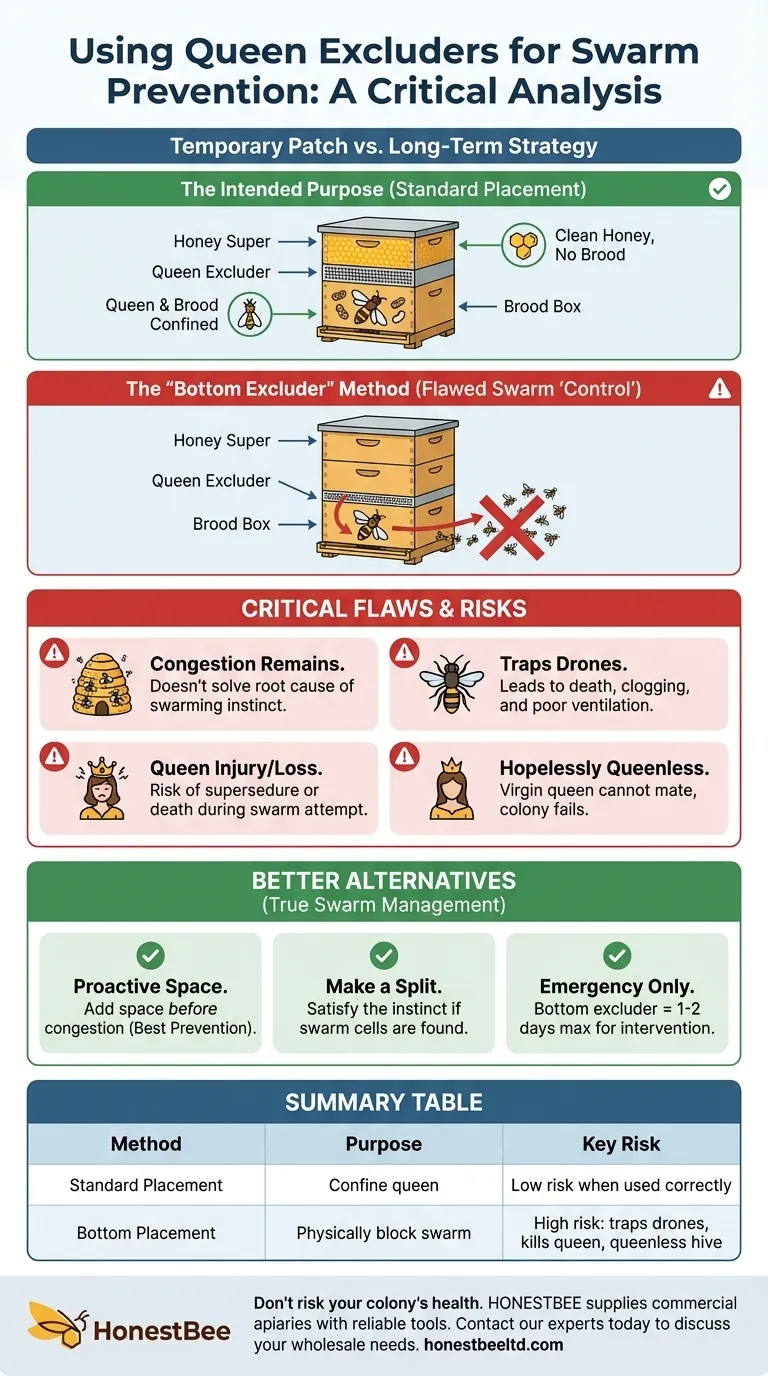To be direct, a queen excluder can be used as a physical barrier to prevent a queen from leaving the hive during a swarm. This is done by placing the excluder between the bottom-most brood box and the bottom board, effectively trapping the queen inside the hive.
While this method physically contains the queen, it is a flawed and often detrimental strategy. It acts as a temporary patch that fails to address the core biological instinct to swarm, potentially creating more significant problems for the colony.

The Intended Purpose of a Queen Excluder
A queen excluder is a simple but precise tool designed for one primary function: managing where the queen lays her eggs.
How an Excluder is Built
A queen excluder is a perforated screen, typically made of metal or plastic. The slots are engineered to be large enough for worker bees to pass through but too narrow for the larger thorax of a queen bee (and also drones).
The Standard Placement and Use
In conventional beekeeping, the excluder is placed above the brood boxes and below the honey supers. This confines the queen to the brood chamber, ensuring she lays eggs only where you want them, keeping the honey supers free of brood and pollen.
The "Bottom Excluder" Method for Swarm Control
Some beekeepers attempt to use this tool for a completely different purpose: swarm prevention. The logic seems straightforward but is ultimately shortsighted.
The Theory of Operation
When a colony decides to swarm, the old queen and about half the bees will leave the hive. By placing the excluder at the very bottom, the workers can exit, but the queen cannot.
When the swarm discovers the queen is not with them, they will typically return to the original hive. The immediate departure of the swarm is averted.
Critical Flaws and Unintended Consequences
Using an excluder at the hive entrance is not swarm prevention; it's queen imprisonment. This approach ignores the root cause of the swarming impulse and introduces serious risks.
It Fails to Solve the Core Problem
Swarming is a natural reproductive instinct triggered by specific conditions, most notably congestion. A crowded hive with no room for the queen to lay signals the colony to divide. Placing a barrier at the entrance does absolutely nothing to relieve this internal pressure. The swarming instinct remains.
It Blocks Drone Movement
Drones are male bees, and they are larger than workers. Like the queen, they cannot pass through the excluder. Trapping drones inside the hive means they cannot leave for mating flights. Worse, they will die and clog the excluder, impeding ventilation and blocking returning foragers.
It Can Result in a Lost or Dead Queen
Even if the swarm returns, the colony is still in swarm mode. The bees may attempt to swarm multiple times, stressing and potentially injuring the queen as she tries to exit. In the confusion, the workers may kill (supersede) the old queen and raise a new one from an existing swarm cell.
It Can Lead to a Hopelessly Queenless Hive
If the old queen dies and a new virgin queen hatches, she must leave the hive for a mating flight. If she is also trapped by the excluder, she cannot mate. An unmated queen can only lay unfertilized eggs, which develop into drones. This is a fatal condition for the colony.
Making the Right Choice for Your Hive
True swarm management involves working with the bees' natural instincts, not fighting against them with a physical barrier. Address the "why" behind their impulse to leave.
- If you want a quick, emergency stopgap: Using a bottom excluder can buy you a day or two to perform a proper inspection, but it is not a solution. You must intervene immediately to resolve the underlying issue.
- If your primary focus is effective, long-term swarm prevention: Proactively manage hive congestion by adding more space (brood boxes or honey supers) before the colony becomes crowded. This is the single most effective prevention method.
- If you have already found swarm cells: Do not rely on an excluder. The decision to swarm has already been made. Your best course of action is to make a split, which satisfies the colony's instinct to divide while allowing you to retain the bees.
Ultimately, preventing swarms is about understanding and managing the conditions that cause them, ensuring your colony remains healthy, productive, and in its hive.
Summary Table:
| Method | Purpose | Key Risk |
|---|---|---|
| Standard Placement (Above Brood Box) | Confine queen to brood chamber, keep honey supers clean. | Low risk when used correctly. |
| Bottom Placement (For 'Swarm Control') | Physically block queen from leaving with a swarm. | High risk: traps drones, can kill/maim queen, leads to queenless hive. |
Don't risk your colony's health with a flawed swarm prevention method. Proper hive management is key to a thriving apiary. HONESTBEE supplies commercial apiaries and beekeeping equipment distributors with the reliable, high-quality tools needed for effective beekeeping. Let us help you build a stronger operation. Contact our experts today to discuss your wholesale needs.
Visual Guide

Related Products
- Premium Wood Framed Metal Wire Queen Bee Excluder
- Professional Plastic Queen Excluder for Modern Beekeeping
- High Performance Plastic Queen Excluder for Beekeeping and Apiary Management
- Metal Queen Bee Excluder for Beekeeping
- Plastic Queen Bee Excluder for Bee Hive Wholesale
People Also Ask
- What are the advantages of using queen excluders? Boost Honey Production & Hive Management
- Can a queen get through a queen excluder? A Guide to Preventing Hive Failures
- What makes polyurethane foam environmentally friendly? The Surprising Benefits of a Durable, Inert Material
- What is the primary function of a queen excluder? A Guide to Brood-Free Honey Harvesting
- Where should a queen excluder be placed in a beehive? The Key to Hive Organization



















